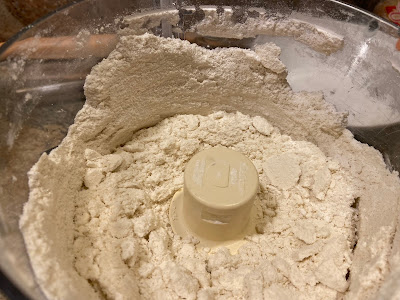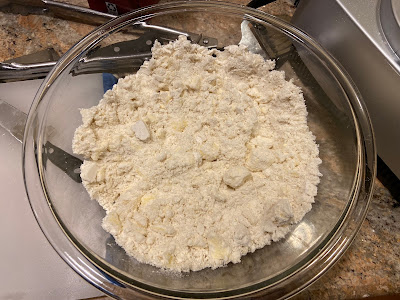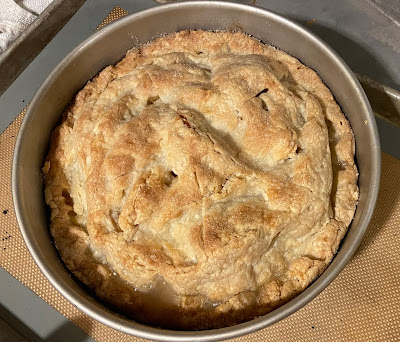In brief, this is what I do. Note that some parts of my process defy traditional methods.
- I make an all butter crust; butter is integrated in two separate steps using different mixing methods.
- When cutting in the butter, I leave the chunks large (marble-sized).
- Ice water is mixed in by hand, not in the food processor.
- Crust can be rested and then rolled, or rolled and then rested; order doesn’t matter. (Some bakers think this is heresy, but it works for me.)
- Crust is rolled out between sheets of plastic wrap, not on a floured surface.
And now in not-brief, here is my definitive process of making pie.
What makes a flaky crust:
The primary thing to many pie bakers and eaters, and possibly the most contentious, is how one achieves the perfect balance of tenderness, flakiness, and taste. Many people swear by a combination of fats — part butter and part Crisco or lard. Here I can offer a food-science explanation for why a combination of fats typically results in a flaky crust, and some different ways to achieve that.
One of the keys to making a pie crust that is crispy and flaky is not what specific combination of fats you use, but rather the result of how those different fats disperse when you cut them into the flour. Cold butter stays in firm chunks, whereas Crisco/lard will quickly disperse and coat the individual flour grains. The combination of fat-coated flour grains and firm chunks of fat is the goal. But it’s not necessary to use multiple different fats to get this effect. I've identified three different ways of getting this effect using all butter.
- Divide the butter ahead of time, keep most of it cold and let a portion come to room temperature; cut into the flour in one step just as you would butter + Crisco/lard. OR,
- Keep all the butter cold and add in two separate steps: first blend in a portion completely until the flour grains are coated, then cut in the rest, leaving large chunks. (This is how I do it.) OR,
- Keep all the butter cold and cut into the flour, leaving large chunks, then rub the mix with your hands until the flour starts to get slightly sticky.
Pro-tip: cutting in butter using any of these methods also applies to making excellent biscuits and scones.
Note that you’re not limited to Crisco and lard as alternative fats. Duck, beef and lamb fat, to name a few, are also great choices especially for savory pies. Coconut oil would probably be great also, but I haven't tried that.
Here is how I make my crust.
Ingredients:
- 320 g flour (same weight gluten-free or wheat) This is about 2-2 1/2 cups.
- 1 c unsalted butter (divided into 3/4 c and 1/4 c, cubed & cold)
- 1 tsp salt
- 8-12 Tb ice water
- (GF only — 1 tsp vinegar. This is recommended by America's Test Kitchen to help with flakiness. I often forget to add it though, and my GF crust still turns out great.)
Instructions:
1. Put the flour, salt, and 1/4 cup of butter into a food processor. Process on high until the flour begins to stick together very slightly as it spins around the bowl. There should be no visual trace of the butter; it should be completely integrated.
2. Sprinkle the remaining 3/4 c cold cubed butter into the flour mix. Pulse a few times until you have marble-size chunks. This is larger than what most cooks recommend, but this is what works for me. I prefer to be conservative, and to cut up any too-big pieces later if I deem necessary.
Pro-tip: consider making an extra bag of this flour mix and storing it in the fridge, in the event that you accidentally add too much ice water in the next step. If that happens and you add more plain flour to compensate, your result will not be as good.
3. Pour the flour mix from the food processor into a bowl so that you can mix in the ice water by hand. Mixing by hand gives you much more control over working the dough as little as possible and also maintaining the desired size of the butter chunks. Picture below shows the mix before any water is added.
4. Start with 8 tablespoons of ice water. (If you are making a GF crust, first add the teaspoon of vinegar to this water.) Stir briskly around the periphery of the bowl with a fork, occasionally cutting through the middle of the bowl. This movement should moisten everything evenly with as little working of the mix as possible. Picture below shows the mix with 8 Tb ice water incorporated. Sometimes this is enough for the dough to stick together, but not this time. It looks a little different from the photo just above, but there is not yet enough water in this dough.
5. If after adding 8 Tb of ice water your mix is still a little dry, add another 2-3 Tb. The dough pictured below has the right amount of water for it to stick together when pressed. (For reference, I find that 10 Tb is usually perfect. I never need more than 12 Tb.)
Note that the mix is still “shaggy” — you don’t keep adding water until the dough sticks together, just until it is barely and evenly moistened. (As per pro-tip, if your result is too wet, compensate by adding flour mix from your reserve bag held just for this purpose.)
6. Press the shaggy dough together gently; do not knead or compress into a firm ball. Cut into 2 roughly equally sized pieces. (If you are making hand pies, one batch of dough makes eight equally sized pieces, probably about 85 g apiece.) Picture below shows 1/2 of the dough, after it is cut into 2 pieces.
7. Press each of these into a round flat disc about 1/2 inch thick on a piece of plastic wrap, seal and rest in the fridge for an hour or so. Picture shows a tablespoon for scale. Note the spotty surface -- these are the chunks of butter that will melt and leave thin layers of dough, thus creating the sought-after flakiness.
If you choose, you can alternatively roll out right now into the final size and shape, so long as the butter is still cold and firm. If you roll first, you will need to rest in the fridge afterwards.
Resting the dough: This is an important step. The dough needs at least an hour of rest in the refrigerator, either before or after rolling. If it’s a wheat crust, the resting time helps the gluten to relax after mixing/rolling, which yields a more tender result. If it’s a GF crust, it needs time to absorb the moisture in the dough because the grains in GF flour are less permeable than wheat. In both cases, keeping the dough cold is important because that keeps the butter firm, which is key to a flaky crust.
Rolling the dough: Make sure you lay out enough plastic wrap to accommodate the final size and shape you want (it may be multiple sheets wide for a full size pie). As cracks form along the edge, compress them together using the plastic wrap to apply pressure. The plastic wrap may tear as you roll it; peel and replace as necessary.
Pictures below show a small piece of dough for a 2-crust mini tart. As you begin to roll, cracks will inevitably form along the edge.
Below: Fold the plastic wrap over the cracked area and compress; then unfold and continue rolling. Repeat folding, compressing, and unfolding as necessary.
2. Flip over, remove the other side of the plastic wrap.
3. Plastic side up, position the crust centered over your pie plate and press into the sides. Do this gently; the more pressure you apply when pressing into the plate, the tighter the plastic will adhere to the surface, the softer your dough will get, and the trickier it will be to remove the plastic without tearing the dough.
4. Carefully remove remaining plastic wrap.
Then, fill as desired. If you’re making a double crust pie, repeat the above steps with the top crust. Crimp sides as you wish. Make sure to cut vents in the top so the sides don’t blow apart.
Here is what I do for my apple pie filling.
Apple filling ingredients:
- 5 medium sized apples, a combination of Granny Smith and some other firm high acid variety like Honeycrisp
- 1/2 c white or brown sugar
- 32 g flour (about 1/3 to 1/2 the volume of sugar)
- 1/2 tsp cinnamon
- Juice of one lemon
- 1 Tb melted butter
Optional add-ins: 1/2 tsp salt, other spices like ground cardamom, coriander, or cloves, or even savory spices like red pepper or paprika. You can also add sharp cheese, or a custard or frangipani filling. Fresh halved cranberries is one of my favorite add-ins.
Instructions:
1. Apple pieces should be medium-thin; first peel and quarter the apples, then cut each quarter into 4-5 slices.
2. In a separate bowl, mix together the sugar, flour, and cinnamon. It’s important to do this before you add to the apples, otherwise you might get clumps of flour.
3. Add the sugar mix to the apples and stir. Add the lemon juice, then the melted butter. Arrange the apples inside the bottom crust as desired.
4. Top with the second crust, crimp sides, cut vents, finish surface as desired. I like to dust with granulated sugar, and I don’t bother with egg wash.
5. Place in the lower third of the oven, bake at 375° with convection on for a total of 50 to 60 minutes, rotating halfway through the baking process. The pie is done when you start to see syrupy bubbles coming through the top vents and/or the crust edge. Do not judge by the appearance of the crust. If it’s getting brown but not yet bubbling, try moving it to a lower rack of the oven and/or placing a sheet of foil on top of it.
Note that if you are making a GF crust, I recommend you have some support around the side of the pie plate, because GF pie crust tends to spread over the edge and break off. If your pie plate can slip snugly into a springform pan, that’s perfect.
Another way to provide support for GF pies is to construct a foil collar and staple it together around the periphery. The picture below shows 4" mini GF tarts in and out of their little makeshift foil pans.
I hope you find this photo-documentation useful in your pie making. I believe we each have our own ways of doing things, and I encourage you to make your pie process your very own. Trust your instincts and have fun!















